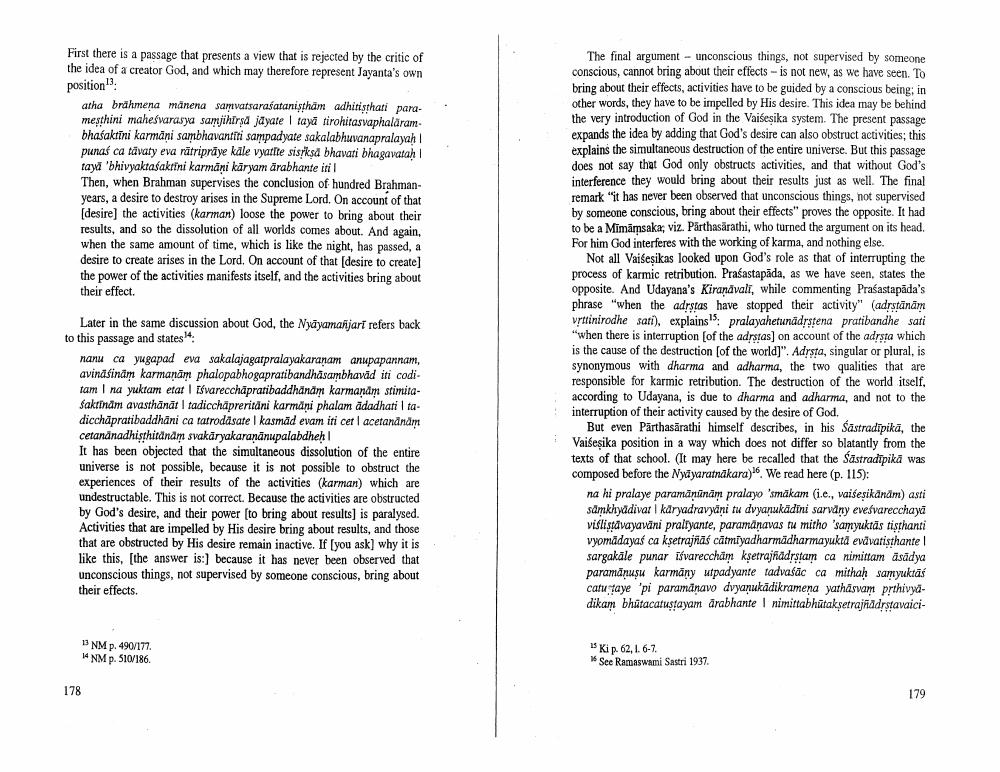Book Title: Mimamsa Versus Vaisesika Author(s): Johannes Bronkhorst Publisher: Johannes Bronkhorst View full book textPage 5
________________ First there is a passage that presents a view that is rejected by the critic of the idea of a creator God, and which may therefore represent Jayanta's own position": atha brahmena manena samvatsarasatanistham adhitisthati paramesthini mahesvarasya sajihirsd jayate Itaya tirohitasvaphalarambhafaktini karmāni sambhavantiti sampadyate sakalabhuvanapralayah punas ca tavaty eva rätripriye kale vyarfte sisyksd bhavati bhagavatah tayd 'bhivyakta aktini karmani karyam drabhante iti Then, when Brahman supervises the conclusion of hundred Brahmanyears, a desire to destroy arises in the Supreme Lord. On account of that [desire) the activities (karman) loose the power to bring about their results, and so the dissolution of all worlds comes about. And again, when the same amount of time, which is like the night, has passed, a desire to create arises in the Lord. On account of that (desire to create] the power of the activities manifests itself, and the activities bring about their effect. Later in the same discussion about God, the Nyayamanjarf refers back to this passage and states: nanu ca yugapadeva sakalajagatpralayakaranam anupapannam, avinafinám karmand phalopabhogapraribandhasambhawid iti coditam i na yuktam etar Svarecchápratibaddhand karmandm stimitaSakrinam avasthanar tadicchapreridni karmani phalam adadharita dicchåpratibaddhani ca tatroddsate I kasmad evam iti cer acetandnam cetandnadhisthirdnam svakaryakarananupalabdheh It has been objected that the simultaneous dissolution of the entire universe is not possible, because it is not possible to obstruct the experiences of their results of the activities (karman) which are undestructable. This is not correct. Because the activities are obstructed by God's desire, and their power to bring about results] is paralysed. Activities that are impelled by His desire bring about results, and those that are obstructed by His desire remain inactive. If you ask) why it is like this, (the answer is:) because it has never been observed that unconscious things, not supervised by someone conscious, bring about their effects The final argument - unconscious things, not supervised by someone conscious, cannot bring about their effects - is not new, as we have seen. To bring about their effects, activities have to be guided by a conscious being, in other words, they have to be impelled by His desire. This idea may be behind the very introduction of God in the Vaisesika system. The present passage expands the idea by adding that God's desire can also obstruct activities; this explains the simultaneous destruction of the entire universe. But this passage does not say that God only obstructs activities, and that without God's interference they would bring about their results just as well. The final remark "it has never been observed that unconscious things, not supervised by someone conscious, bring about their effects" proves the opposite. It had to be a Mimämsaka, viz. Parthasarathi, who turned the argument on its head. For him God interferes with the working of karma, and nothing else. Not all Vaišeşikas looked upon God's role as that of interrupting the process of karmic retribution. Prasastapāda, as we have seen, states the opposite. And Udayana's Kiranavall, while commenting Prasastapāda's phrase "when the adrstas have stopped their activity" (adrstānām vrttinirodhe sati), explains's pralayahetunddrstena pratibandhe sati "when there is interruption of the adestas) on account of the adrsta which is the cause of the destruction (of the world)". Adrsta, singular or plural, is synonymous with dharma and adharma, the two qualities that are responsible for karmic retribution. The destruction of the world itself, according to Udayana, is due to dharma and adharma, and not to the interruption of their activity caused by the desire of God, But even Parthasarathi himself describes, in his Sastradīpikā, the Vaiseșika position in a way which does not differ so blatantly from the texts of that school. (It may here be recalled that the Sastradīpika was composed before the Nyd yaratnakara). We read here (p. 115): na hi pralaye paramarānām pralayo 'smakam (.e., vai esikandm) asti samkhyadivarl karyadravyani tu dvyarukadini sarvany evefvarecchaya vislistavayavani prallyante, paramanavas tu mitho 'samyuktas tisthanti vyomádayas ca kşetrajñaś catmiyadharmadharmayukta evdvaristhantel sargakäle punar tvareccham kşetraffidrstam ca nimittam asadya paramāņusu karmány utpadyante tadvaśāc ca mithah samyuktās catutaye 'pi paramdnavo dvyanukādikramena yarhasvam pythivyadikam bhūtacatusfayam drabhantel nimittabhatakşetrajfddrstavaici NM p. 490/177. NM p. 510/186. 1 ki p. 62, 1. 6-7. 1 See Ramaswami Sastri 1937. 178 179Page Navigation
1 ... 3 4 5 6
